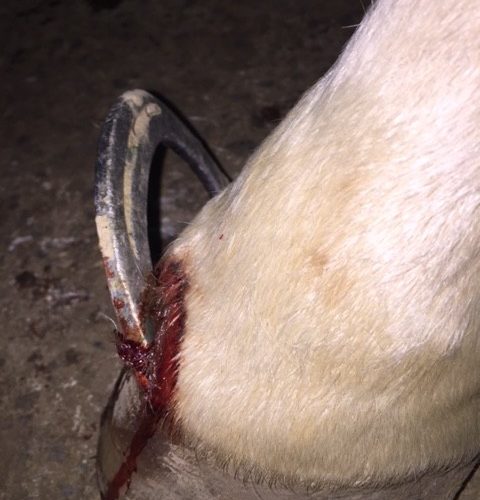Emergencies of the Hoof –
By: Dr. Gina Tranquillo
Lacerations and wounds are common emergencies for veterinarians, especially after hours, but a horse shoe stuck in the foot? Well, Dr. Tranquillo was called out the evening before Halloween on emergency to see just this. Pictures are attached, so watch your queasy stomach!
A foreign body in the hoof such as a shoe, a nail, a screw, etc is an emergency we all dread as horse owners. It is definitely an emergency and you need to call your veterinarian should you find something like this stuck in your horse’s foot. The goal is for the veterinarian to remove the foreign body and appreciate what vital structures, if any, were involved or penetrated. With this knowledge, the veterinarian can properly treat the horse long term.
In this case, the shoe did belong to the patient. It was his front shoe and he somehow wedged it between his frog and the coronet despite having front bell boots on. Luckily he was found literally seconds after the incident happened, so he was not stuck outside in the pasture limping around. He was promptly brought to the barn, given some pain reliever by the owner, and the veterinarian was promptly called. Over the phone until the vet’s arrival, the owner was asked to keep the horse calm by having him stand still with a pile of hay.
On arrival, Dr. Tranquillo performed an abbreviated evaluation to gauge the horse’s clinical status, and then sedated the horse to relieve him from moving about in pain while she performed her detailed assessment. Then she was able to get help from the barn crew to help cut the shoe in half without too much torque so it could be removed.
The resulting wound on the coronet was clipped, thoroughly cleaned, evaluated and a sterile preparation was performed to tap the coffin joint. The coffin joint fluid was normal and there was no communication with the wound. Luckily for the horse, the coffin joint was not involved and the shoe on the underside only communicated with the frog but did not penetrate underlying tissues. At this stage, the wound on the coronet could be treated like a wound that needed to heal from the inside out.
The horse was placed on antibiotics, pain medications and anti-inflammatories, daily bandage changes, stall rest, and vaccine history was taken into consideration to make appropriate recommendations. There will be a follow up examination in one week to judge progress and wound healing. In this case, the horse was very lucky! Look for an update in the near future to see how this horse is doing!
In any case of wound healing, it is always important to monitor your patient at home. Clinical signs that should prompt you to call your veterinarian are: fever, lameness, a horse that is down and cannot rise, significant swelling, diarrhea and/or anorexia if they are on antibiotics, pus at the wound site or signs of infection, any pain of the skin located around the wound with warmth, and any attitude changes in the horse such as depression or lethargy.


